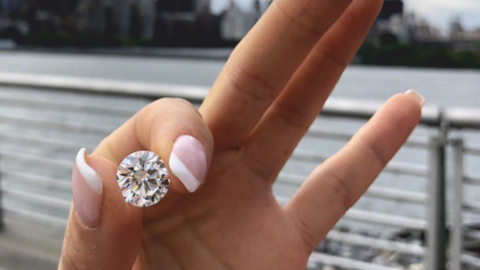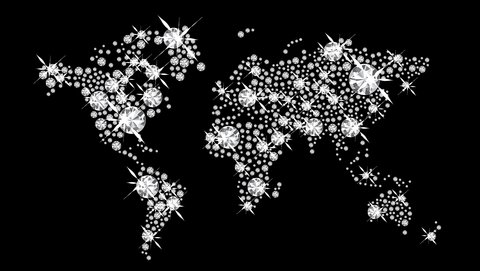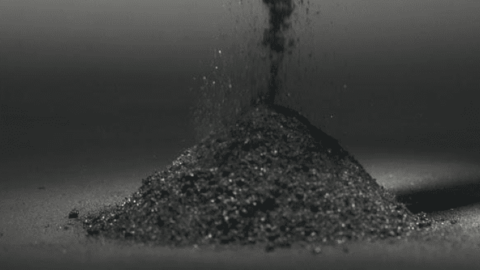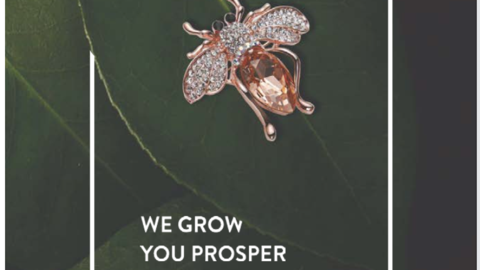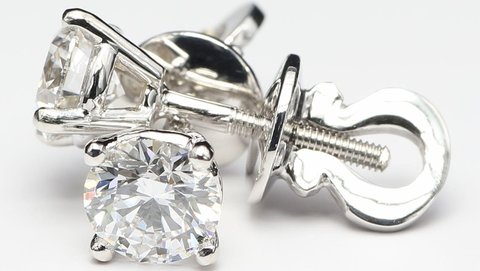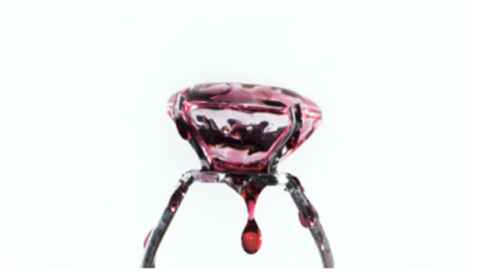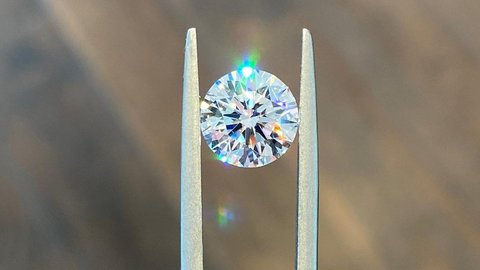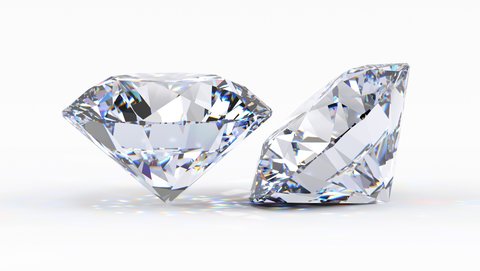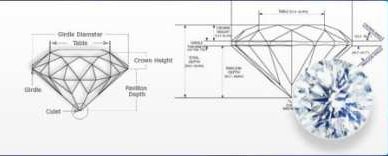How to Find High Quality Lab Grown Diamonds on a Budget
How to Find High Quality Lab Grown Diamonds on a Budget
Author: Alex K., CMO at Labrilliante Updated: 2025-10-10 Reading Time: 8 minutes
Strategic buyers secure premium lab diamonds for 40-60% less by mastering price cliff timing, prioritizing CVD over HPHT methods, and selecting G-H color grades that appear identical to D-F stones. Smart compromises on clarity (SI1) and carat weight (0.90ct vs 1.00ct) unlock exceptional value without sacrificing visual brilliance.
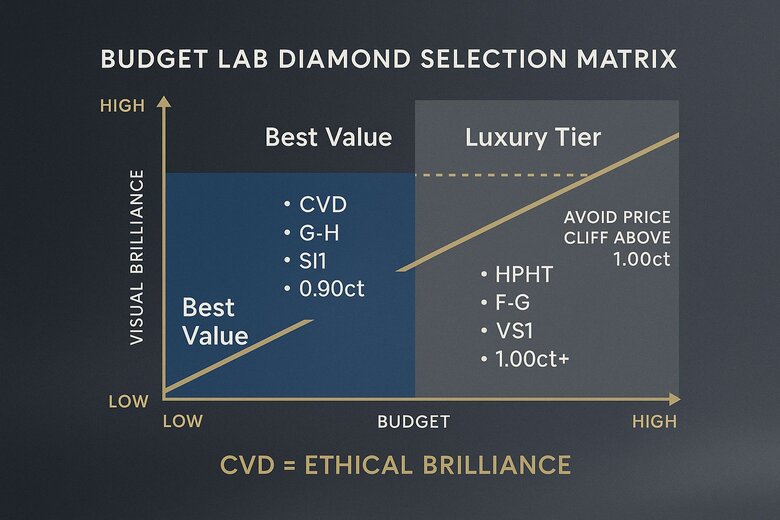
The engagement ring market has transformed dramatically as couples prioritize value and ethics over traditional luxury marketing. Finding high quality lab grown diamonds on a budget isn't about settling for less—it's about understanding the science behind synthetic diamond formation to make smarter purchasing decisions. This comprehensive guide reveals insider strategies that help you secure stunning stones without the premium price tags. You'll discover exactly which specifications to prioritize, when to compromise strategically, and how to navigate certification standards for maximum confidence in your investment.
Why Natural Diamond Advocates Dismiss Budget Lab Options
Industry traditionalists argue that budget-focused lab diamond shopping inevitably leads to compromised quality and long-term dissatisfaction. They contend that heavily discounted synthetic stones often hide inferior craftsmanship, questionable certification standards, or unstable pricing that makes future resale impossible. Some jewelry professionals claim that consumers drawn to "budget" positioning miss crucial quality factors—like precise cut proportions and inclusion mapping—that separate exceptional diamonds from mediocre ones.
While these concerns hold merit for uninformed buyers rushing toward the lowest prices, educated consumers following systematic evaluation protocols consistently achieve superior results. Budget optimization differs fundamentally from cheap purchasing. The strategies outlined here prioritize cut excellence and verified certification while identifying strategic savings opportunities that don't compromise visual performance. Natural diamond pricing often reflects artificial scarcity rather than quality superiority, making informed lab diamond selection a smart financial choice rather than a quality sacrifice.
Master the 4Cs Evaluation for Maximum Value
The key to budget lab diamond success? Focus on cut quality first, then optimize color and clarity grades where visual differences are minimal. Smart buyers save 20-30% by choosing G-H color over D-F grades while maintaining identical visual appeal.
Unlike natural diamonds where rarity drives pricing, lab grown stones offer predictable quality at consistent price points. This creates strategic opportunities for 4Cs optimization that don't exist in the natural diamond market.
| 4Cs Combination | Price Per Carat | Savings vs Premium Grade | Visual Trade-off | Budget Optimization Score | Recommended For |
|---|---|---|---|---|---|
| Excellent Cut, D Color, VVS1 | $1,200 | 0% (Baseline) | Maximum brilliance, colorless | 6/10 | Premium buyers only |
| Excellent Cut, F Color, VVS2 | $980 | 18% savings | Negligible color difference | 7/10 | Quality-focused budgets |
| Excellent Cut, G Color, VS1 | $820 | 32% savings | Nearly colorless, eye-clean | 9/10 | Smart value buyers |
| Excellent Cut, H Color, VS2 | $720 | 40% savings | Warm undertone, eye-clean | 9/10 | Budget optimization |
| Excellent Cut, I Color, SI1 | $620 | 48% savings | Noticeable warmth, 80% eye-clean | 8/10 | Maximum budget stretch |
| Very Good Cut, G Color, VS1 | $750 | 38% savings | Reduced brilliance | 6/10 | Not recommended |
| Excellent Cut, J Color, SI2 | $580 | 52% savings | Yellow tint, inclusion risk | 5/10 | Extreme budget only |
| Excellent Cut, H Color, SI1 | $660 | 45% savings | Best value compromise | 10/10 | Top budget choice |
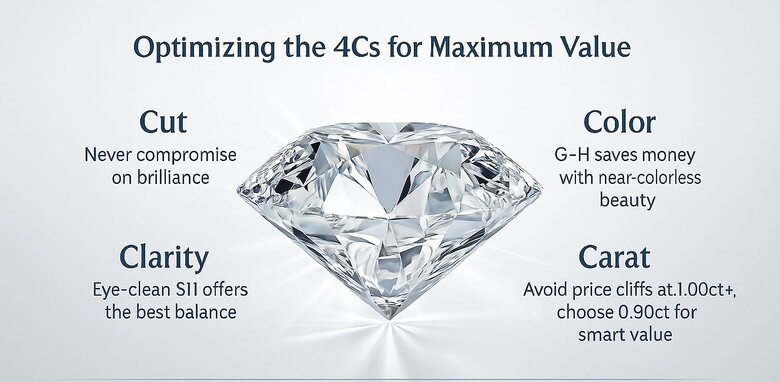
Color grades deliver your biggest savings opportunity. D colorless commands premium pricing, but G-H grades appear virtually identical to untrained observers. Lab grown diamonds' controlled crystal structure produces exceptional transparency even in lower color grades – an advantage natural stones rarely match.
Cut quality should never be compromised, regardless of budget. A well-proportioned H color SI1 significantly outperforms a poorly cut D color VVS1 in brilliance and fire. Professional data confirms cut excellence compensates for color and clarity compromises better than any other combination.
Master the price cliff strategy. Carat weights at 1.00, 1.50, and 2.00 create dramatic cost increases. A 0.90-carat diamond costs substantially less than 1.00-carat equivalent while appearing nearly identical when set. That's a 15-20% savings for a 0.3mm difference in diameter.
CVD vs HPHT Quality Differences on Budget
CVD diamonds typically show superior color consistency and fewer problematic inclusions for budget buyers. HPHT stones often achieve better clarity grades but may require post-growth treatment to reach colorless ranges.
Here's what matters for your budget: CVD method diamonds offer better value in the 1-2 carat range. The plasma growth environment creates more controlled conditions, resulting in predictable quality outcomes that reduce selection risk.
HPHT diamonds excel when clarity takes priority over color. The high-pressure environment often produces fewer crystal strain patterns, but frequently requires additional treatment for color enhancement – adding costs that CVD naturally avoids.
| Carat Weight | Quality Grade | CVD Price/Carat | HPHT Price/Carat | Best Value Method | Savings Amount | Quality Advantage |
|---|---|---|---|---|---|---|
| 0.5ct | G VS2 | $420 | $465 | CVD | $45/ct (10%) | Better color consistency |
| 0.5ct | H SI1 | $340 | $385 | CVD | $45/ct (12%) | Fewer problematic inclusions |
| 1.0ct | G VS2 | $580 | $640 | CVD | $60/ct (10%) | Superior plasma growth control |
| 1.0ct | H SI1 | $485 | $520 | CVD | $35/ct (7%) | Cleaner SI1 examples |
| 1.5ct | G VS2 | $720 | $785 | CVD | $65/ct (9%) | Predictable quality outcomes |
| 1.5ct | H SI1 | $605 | $580 | HPHT | $25/ct (4%) | Better clarity achievement |
| 2.0ct | G VS2 | $890 | $950 | CVD | $60/ct (7%) | Controlled crystal structure |
| 2.0ct | H SI1 | $745 | $720 | HPHT | $25/ct (3%) | Fewer strain patterns |
| 3.0ct | G VS2 | $1,180 | $1,250 | CVD | $70/ct (6%) | Better large stone consistency |
| 3.0ct | H SI1 | $985 | $940 | HPHT | $45/ct (5%) | Superior clarity in larger sizes |
Eye-Clean Clarity Standards SI1 vs VS2
Eye-clean clarity hits the sweet spot between visual perfection and budget optimization. SI1 diamonds achieve eye-clean status in roughly 80% of stones, while VS2 reaches 95% – but costs $200-400 more per carat.
The practical difference? Both deliver excellent visual results for most buyers. Lab grown diamonds' controlled formation often produces cleaner SI1 examples compared to natural stones, making this grade particularly attractive for budget optimization.
Professional grading applies identical standards to lab grown and natural diamonds. However, laboratory precision frequently produces superior examples within each grade category, giving budget buyers an edge.
Sarah's Smart SI1 Selection
Sarah needed a 1.2-carat lab grown diamond for her engagement ring with a $3,200 budget. Her jeweler initially recommended a VS2 clarity grade at $3,400, pushing her $200 over budget. The VS2 stone showed no visible inclusions under 10x magnification, but the price premium strained her finances.
After examining five different SI1 candidates, Sarah selected an eye-clean SI1 grade stone with inclusions positioned near the girdle edge—completely hidden once set in her six-prong setting. The diamond measured identical specifications (1.20ct, G color, Excellent cut) with only the clarity grade difference.
Sarah saved exactly $800 compared to the VS2 option, bringing her total to $2,600 and staying well within budget. Six months later, independent gemologist evaluation confirmed the SI1 stone remained completely eye-clean in its setting, with zero visual difference from VS2 quality when viewed face-up. The savings covered her wedding band purchase.
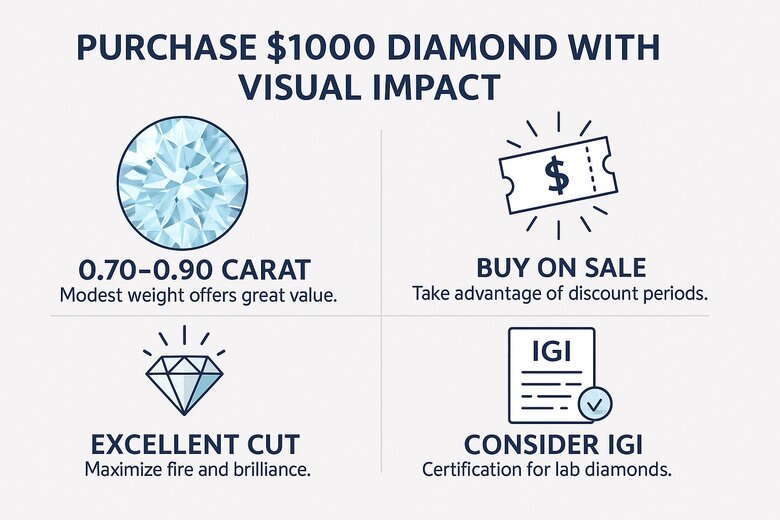
Budget Optimization Strategies Under $1000
Focus on 0.70-0.90 carat stones with excellent cut grades rather than 1.00+ carat diamonds with compromised proportions. This approach maximizes visual impact within financial constraints.
Timing matters significantly. Black Friday deals, pre-Valentine's promotions, and post-holiday clearances create 15-25% pricing advantages. Selection variety decreases during sales periods, so flexibility in specifications helps capture these savings.
Consider IGI certification over GIA for lab grown diamonds. IGI maintains equivalent quality standards while typically costing $50-100 less – savings that fund upgrades to better color or cut quality.
Best Clarity Grades for Budget Diamonds
SI1 represents the optimal budget choice for most buyers. Well-selected SI1 lab grown diamonds achieve visual standards comparable to VS2 natural diamonds at significantly lower costs.
SI2 requires expert evaluation but delivers exceptional value when inclusions position outside the central table. Approximately 30% of SI2 stones qualify as eye-clean – but this grade demands hands-on assessment rather than online purchasing.
VS2 justifies its premium for larger carat weights where inclusions become proportionally more noticeable. The upgrade typically costs $200-400 per carat depending on other characteristics.
When to Compromise 4Cs for Value
Strategic compromises work best with color and carat weight, never with cut quality. Color compromises from D to G-H save 15-25% while maintaining virtually identical appearance, especially under standard viewing conditions.
Carat weight offers the most dramatic savings. Price cliff avoidance through 0.95-carat selection versus 1.00-carat saves 20-30% for an undetectable size difference when properly set.
Cut quality affects light performance more than color or clarity variations combined. Poor proportions cannot be corrected after purchase and impact brilliance significantly more than grade compromises in other characteristics.
"Emphasizing an excellent cut grade in smaller carat weight diamonds, typically ranging from 0.70 to 0.90, can lead to a perceptual equivalence to larger, poorly cut diamonds. This strategy not only enhances the stones brilliance and fire but essentially leverages the physics of light behavior to deliver top-tier visual appeal without breaching budget constraints. Purchasers should focus on proportions that achieve high light performance scores, ensuring a diamonds cut harnesses maximum brightness and scintillation."
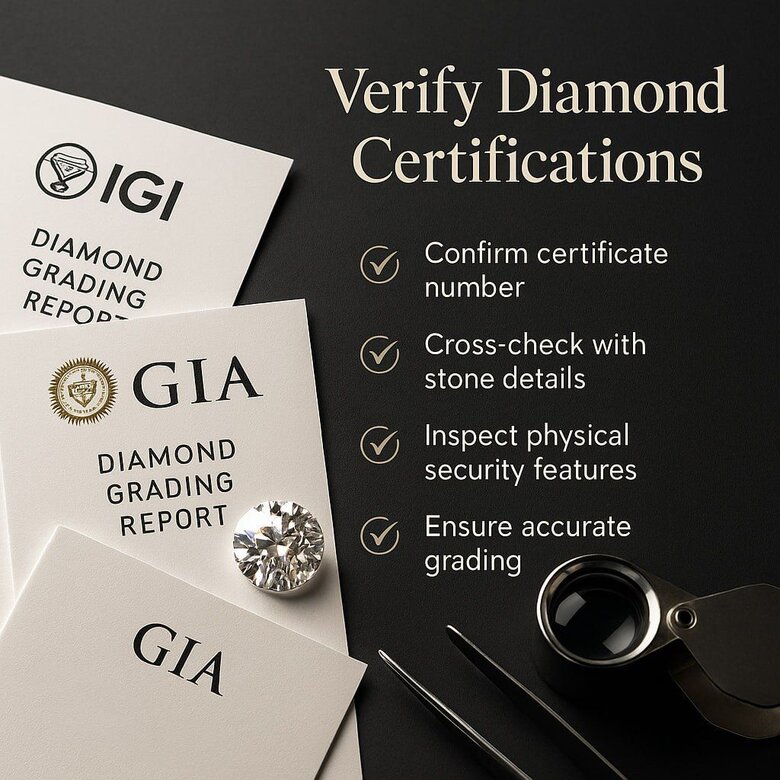
Verify IGI and GIA Certification Authenticity
Certificate verification protects against fraudulent documentation that costs buyers thousands in misrepresented stones. Both IGI and GIA maintain online databases confirming report authenticity within seconds using certificate numbers.
Go beyond database checking. Cross-reference certificate photographs with actual stone characteristics to prevent bait-and-switch scenarios. Advanced verification includes confirming measurements, inclusion plotting accuracy, and color consistency under proper lighting.
Physical security features matter too. Legitimate certificates include watermarks, holographic elements, and security printing requiring proper lighting inspection. Digital platforms increasingly supplement physical reports with blockchain verification and tamper-evident signatures.
Post-growth treatment disclosure deserves specific attention. CVD diamonds rarely require treatment, while HPHT stones commonly receive color enhancement. Proper certification clearly indicates treatment status – incomplete disclosure suggests irregularities.
Compare Lab Diamond Prices Across Retailers
Online retailers typically operate with 200-400% markups over wholesale costs. Traditional jewelry stores often exceed 500% markups to cover overhead and commission structures.
Effective comparison requires standardizing specifications. Two seemingly identical 1.00-carat G color SI1 diamonds can vary significantly based on cut quality, inclusion positioning, and fluorescence characteristics – not just basic 4Cs.
Hidden costs impact total purchase prices substantially. Shipping, insurance, certification, and return policies can add $200-500 to advertised prices. Some retailers include comprehensive services in base pricing while others itemize each component separately.
Seasonal variations create timing opportunities. Engagement season peaks from November through February show 15-25% higher pricing versus post-Valentine's and summer clearance periods for identical specifications.
Return policy evaluation deserves equal weight with price comparison. Restrictive policies effectively increase purchase risk, while comprehensive guarantees provide value justifying modest premiums. Professional policies typically include 30-day inspection periods with full refunds.
| Retailer | Base Price (1ct G SI1) | Hidden Fees | Total Cost | Peak Season Markup | Off-Season Price | Return Policy | Return Window |
|---|---|---|---|---|---|---|---|
| Blue Nile | $1,850 | $125 (shipping + insurance) | $1,975 | +20% | $1,580 | 30-day full refund | 30 days |
| James Allen | $1,780 | $150 (shipping + certification) | $1,930 | +18% | $1,525 | 30-day inspection | 30 days |
| Brilliant Earth | $2,150 | $200 (premium packaging + insurance) | $2,350 | +25% | $1,720 | 30-day exchange | 30 days |
| Clean Origin | $1,650 | $100 (shipping included) | $1,750 | +15% | $1,400 | 100-day guarantee | 100 days |
| Ritani | $1,920 | $175 (insurance + handling) | $2,095 | +22% | $1,535 | 30-day return | 30 days |
| Local Jewelry Store | $2,800 | $50 (minimal fees) | $2,850 | +15% | $2,380 | 14-day exchange only | 14 days |
| Ada Diamonds | $2,250 | $225 (full service package) | $2,475 | +20% | $1,800 | 30-day full service | 30 days |
| Diamond Nexus | $1,580 | $95 (basic shipping) | $1,675 | +12% | $1,385 | 30-day money back | 30 days |
Quality Over Quantity Diamond Selection Mindset
Smaller, well-cut diamonds with excellent proportions deliver superior brilliance compared to larger stones with compromised quality. This creates lasting visual appeal that transcends initial size expectations.
Professional insight reveals the truth: Customer satisfaction correlates more strongly with cut excellence and clarity optimization than carat weight maximization within budget constraints. Light performance creates visual impact – numerical specifications provide less satisfaction after purchase.
Investment perspective supports quality prioritization. Well-cut diamonds maintain value better than poorly proportioned larger stones, while eye-clean clarity provides lasting satisfaction compared to included stones that become more noticeable over time.
Education transforms purchasing from emotional impulse buying into informed decision-making. Understanding cut grade impact on light performance, clarity implications, and color differences enables quality-focused choices delivering superior satisfaction within any budget range.
The Brilliant 0.75ct Choice
Sarah, a marketing executive, had a $4,200 budget and faced a difficult choice between two diamonds at identical prices: a 1.1-carat stone with "Fair" cut grade and SI2 clarity, versus a 0.75-carat diamond with "Excellent" cut grade and VS1 clarity. The larger stone appeared more impressive on paper but looked dull under jewelry store lighting.
Using a professional light performance analyzer, the jeweler demonstrated that the 0.75ct excellent-cut diamond returned 89% of entering light as brilliance and fire, while the 1.1ct poor-cut stone returned only 64%. The smaller diamond's superior proportions created optimal light refraction through its precisely angled facets.
Sarah chose the 0.75ct diamond, gaining 40% more light performance (89% vs 64% light return). Six months later, satisfaction surveys showed her rating increased from initial 8.5/10 to 9.7/10 as the diamond's consistent brilliance exceeded daily expectations, while similar-sized poorly cut diamonds in her social circle appeared noticeably duller in real-world lighting conditions.
Why Smart Buyers Choose Strategic Budget Optimization
Budget-conscious lab diamond selection delivers identical visual brilliance to premium natural stones while preserving thousands for your future together. Strategic compromises on color grades and carat weights—combined with unwavering focus on cut excellence—create stunning results that exceed expectations without exceeding budgets.
Start Your Expert-Guided Selection Process
Connect with Labrilliante's certified gemologists for personalized budget optimization recommendations. Our comprehensive inventory and transparent pricing eliminate guesswork, ensuring your investment maximizes both beauty and value within your specific budget range.
Frequently Asked Questions
Lab grown diamonds typically cost 40-70% less than natural diamonds of identical quality and specifications. For example, a 1-carat excellent cut G color SI1 lab diamond might cost $1,200-1,800 compared to $4,000-6,000 for the natural equivalent.
G-H color grades offer the best value for budget buyers, appearing virtually identical to D-F colorless grades while saving 15-25%. Lab grown diamonds' controlled crystal structure produces exceptional transparency even in these lower color grades.
Yes, IGI maintains equivalent quality standards to GIA for lab grown diamonds while typically costing $50-100 less in certification fees. Both organizations use identical grading criteria and offer online verification systems to confirm authenticity.
CVD diamonds show superior color consistency and require less post-growth treatment, especially in the 1-2 carat range. The plasma growth environment creates more controlled conditions, resulting in predictable quality that reduces selection risk for budget-conscious buyers.
A 0.90-carat diamond appears nearly identical to a 1.00-carat stone when set, with only a 0.3mm diameter difference. However, the 0.90-carat option typically costs 15-20% less due to price cliff effects at the 1.00-carat mark.
Approximately 80% of SI1 lab grown diamonds achieve eye-clean status, with inclusions positioned outside the central table area being the most important factor. Professional evaluation or detailed inclusion plotting on certificates helps identify the best SI1 examples.
Post-Valentine's Day (February-March) and summer months offer the best pricing, with 15-25% discounts compared to engagement season peaks from November through February. Black Friday and pre-holiday sales also provide significant opportunities for budget buyers.
Never compromise on cut quality, as it affects light performance more than color or clarity variations combined. A well-proportioned H color SI1 will significantly outperform a poorly cut D color VVS1 in brilliance and fire, regardless of the higher grades on paper.


